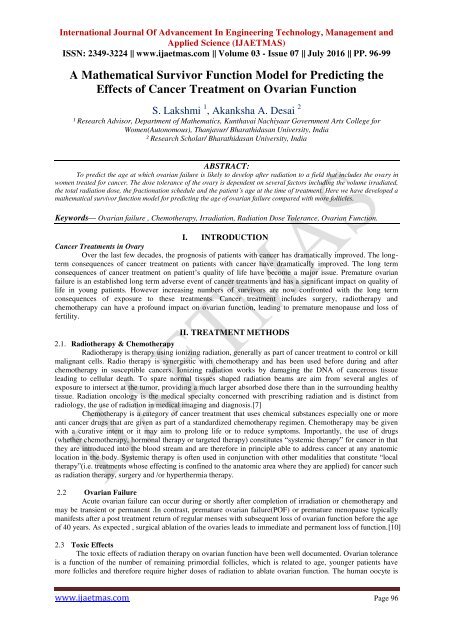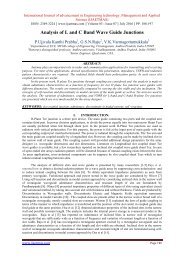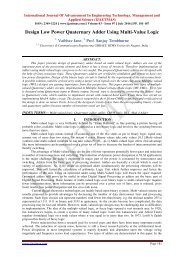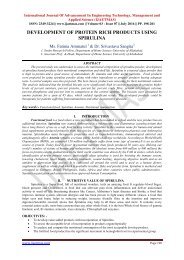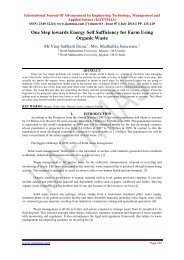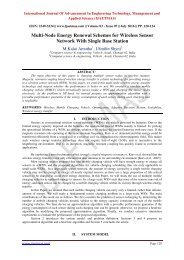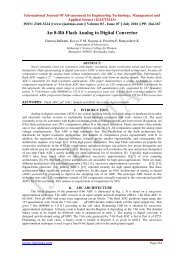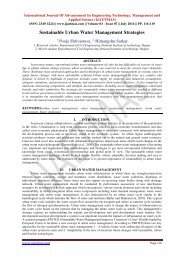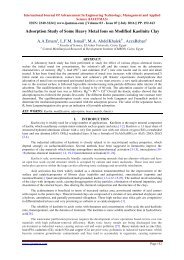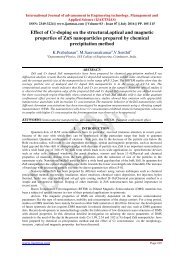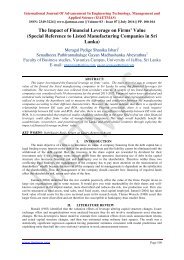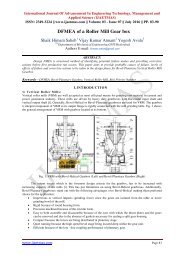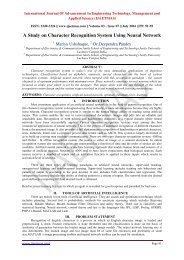A Mathematical Survivor Function Model for Predicting the Effects of Cancer Treatment on Ovarian Function
IJAETMAS is a team of Scientist and academician in field of engineering technology, management science and applied science. It is an international online journal which emphasis on advancement and research in computer and engineering technology, management and Applied science. IJAETMAS accepts original papers for publication in international journal after peer reviewed on monthly basis. IJAETMAS maintain decorum of original work and never compromise on quality.
IJAETMAS is a team of Scientist and academician in field of engineering technology, management science and applied science. It is an international online journal which emphasis on advancement and research in computer and engineering technology, management and Applied science.
IJAETMAS accepts original papers for publication in international journal after peer reviewed on monthly basis. IJAETMAS maintain decorum of original work and never compromise on quality.
You also want an ePaper? Increase the reach of your titles
YUMPU automatically turns print PDFs into web optimized ePapers that Google loves.
Internati<strong>on</strong>al Journal Of Advancement In Engineering Technology, Management and<br />
Applied Science (IJAETMAS)<br />
ISSN: 2349-3224 || www.ijaetmas.com || Volume 03 - Issue 07 || July 2016 || PP. 96-99<br />
A <str<strong>on</strong>g>Ma<str<strong>on</strong>g>the</str<strong>on</strong>g>matical</str<strong>on</strong>g> <str<strong>on</strong>g>Survivor</str<strong>on</strong>g> <str<strong>on</strong>g>Functi<strong>on</strong></str<strong>on</strong>g> <str<strong>on</strong>g>Model</str<strong>on</strong>g> <str<strong>on</strong>g>for</str<strong>on</strong>g> <str<strong>on</strong>g>Predicting</str<strong>on</strong>g> <str<strong>on</strong>g>the</str<strong>on</strong>g><br />
<str<strong>on</strong>g>Effects</str<strong>on</strong>g> <str<strong>on</strong>g>of</str<strong>on</strong>g> <str<strong>on</strong>g>Cancer</str<strong>on</strong>g> <str<strong>on</strong>g>Treatment</str<strong>on</strong>g> <strong>on</strong> <strong>Ovarian</strong> <str<strong>on</strong>g>Functi<strong>on</strong></str<strong>on</strong>g><br />
S. Lakshmi 1 , Akanksha A. Desai 2<br />
¹ Research Advisor, Department <str<strong>on</strong>g>of</str<strong>on</strong>g> Ma<str<strong>on</strong>g>the</str<strong>on</strong>g>matics, Kunthavai Nachiyaar Government Arts College <str<strong>on</strong>g>for</str<strong>on</strong>g><br />
Women(Aut<strong>on</strong>omous), Thanjavur/ Bharathidasan University, India<br />
² Research Scholar/ Bharathidasan University, India<br />
ABSTRACT:<br />
To predict <str<strong>on</strong>g>the</str<strong>on</strong>g> age at which ovarian failure is likely to develop after radiati<strong>on</strong> to a field that includes <str<strong>on</strong>g>the</str<strong>on</strong>g> ovary in<br />
women treated <str<strong>on</strong>g>for</str<strong>on</strong>g> cancer. The dose tolerance <str<strong>on</strong>g>of</str<strong>on</strong>g> <str<strong>on</strong>g>the</str<strong>on</strong>g> ovary is dependent <strong>on</strong> several factors including <str<strong>on</strong>g>the</str<strong>on</strong>g> volume irradiated,<br />
<str<strong>on</strong>g>the</str<strong>on</strong>g> total radiati<strong>on</strong> dose, <str<strong>on</strong>g>the</str<strong>on</strong>g> fracti<strong>on</strong>ati<strong>on</strong> schedule and <str<strong>on</strong>g>the</str<strong>on</strong>g> patient’s age at <str<strong>on</strong>g>the</str<strong>on</strong>g> time <str<strong>on</strong>g>of</str<strong>on</strong>g> treatment. Here we have developed a<br />
ma<str<strong>on</strong>g>the</str<strong>on</strong>g>matical survivor functi<strong>on</strong> model <str<strong>on</strong>g>for</str<strong>on</strong>g> predicting <str<strong>on</strong>g>the</str<strong>on</strong>g> age <str<strong>on</strong>g>of</str<strong>on</strong>g> ovarian failure compared with more follicles.<br />
Keywords— <strong>Ovarian</strong> failure , Chemo<str<strong>on</strong>g>the</str<strong>on</strong>g>rapy, Irradiati<strong>on</strong>, Radiati<strong>on</strong> Dose Tolerance, <strong>Ovarian</strong> <str<strong>on</strong>g>Functi<strong>on</strong></str<strong>on</strong>g>.<br />
I. INTRODUCTION<br />
<str<strong>on</strong>g>Cancer</str<strong>on</strong>g> <str<strong>on</strong>g>Treatment</str<strong>on</strong>g>s in Ovary<br />
Over <str<strong>on</strong>g>the</str<strong>on</strong>g> last few decades, <str<strong>on</strong>g>the</str<strong>on</strong>g> prognosis <str<strong>on</strong>g>of</str<strong>on</strong>g> patients with cancer has dramatically improved. The l<strong>on</strong>gterm<br />
c<strong>on</strong>sequences <str<strong>on</strong>g>of</str<strong>on</strong>g> cancer treatment <strong>on</strong> patients with cancer have dramatically improved. The l<strong>on</strong>g term<br />
c<strong>on</strong>sequences <str<strong>on</strong>g>of</str<strong>on</strong>g> cancer treatment <strong>on</strong> patient’s quality <str<strong>on</strong>g>of</str<strong>on</strong>g> life have become a major issue. Premature ovarian<br />
failure is an established l<strong>on</strong>g term adverse event <str<strong>on</strong>g>of</str<strong>on</strong>g> cancer treatments and has a significant impact <strong>on</strong> quality <str<strong>on</strong>g>of</str<strong>on</strong>g><br />
life in young patients. However increasing numbers <str<strong>on</strong>g>of</str<strong>on</strong>g> survivors are now c<strong>on</strong>fr<strong>on</strong>ted with <str<strong>on</strong>g>the</str<strong>on</strong>g> l<strong>on</strong>g term<br />
c<strong>on</strong>sequences <str<strong>on</strong>g>of</str<strong>on</strong>g> exposure to <str<strong>on</strong>g>the</str<strong>on</strong>g>se treatments. <str<strong>on</strong>g>Cancer</str<strong>on</strong>g> treatment includes surgery, radio<str<strong>on</strong>g>the</str<strong>on</strong>g>rapy and<br />
chemo<str<strong>on</strong>g>the</str<strong>on</strong>g>rapy can have a pr<str<strong>on</strong>g>of</str<strong>on</strong>g>ound impact <strong>on</strong> ovarian functi<strong>on</strong>, leading to premature menopause and loss <str<strong>on</strong>g>of</str<strong>on</strong>g><br />
fertility.<br />
II. TREATMENT METHODS<br />
2.1. Radio<str<strong>on</strong>g>the</str<strong>on</strong>g>rapy & Chemo<str<strong>on</strong>g>the</str<strong>on</strong>g>rapy<br />
Radio<str<strong>on</strong>g>the</str<strong>on</strong>g>rapy is <str<strong>on</strong>g>the</str<strong>on</strong>g>rapy using i<strong>on</strong>izing radiati<strong>on</strong>, generally as part <str<strong>on</strong>g>of</str<strong>on</strong>g> cancer treatment to c<strong>on</strong>trol or kill<br />
malignant cells. Radio <str<strong>on</strong>g>the</str<strong>on</strong>g>rapy is synergistic with chemo<str<strong>on</strong>g>the</str<strong>on</strong>g>rapy and has been used be<str<strong>on</strong>g>for</str<strong>on</strong>g>e during and after<br />
chemo<str<strong>on</strong>g>the</str<strong>on</strong>g>rapy in susceptible cancers. I<strong>on</strong>izing radiati<strong>on</strong> works by damaging <str<strong>on</strong>g>the</str<strong>on</strong>g> DNA <str<strong>on</strong>g>of</str<strong>on</strong>g> cancerous tissue<br />
leading to cellular death. To spare normal tissues shaped radiati<strong>on</strong> beams are aim from several angles <str<strong>on</strong>g>of</str<strong>on</strong>g><br />
exposure to intersect at <str<strong>on</strong>g>the</str<strong>on</strong>g> tumor, providing a much larger absorbed dose <str<strong>on</strong>g>the</str<strong>on</strong>g>re than in <str<strong>on</strong>g>the</str<strong>on</strong>g> surrounding healthy<br />
tissue. Radiati<strong>on</strong> <strong>on</strong>cology is <str<strong>on</strong>g>the</str<strong>on</strong>g> medical specialty c<strong>on</strong>cerned with prescribing radiati<strong>on</strong> and is distinct from<br />
radiology, <str<strong>on</strong>g>the</str<strong>on</strong>g> use <str<strong>on</strong>g>of</str<strong>on</strong>g> radiati<strong>on</strong> in medical imaging and diagnosis.[7]<br />
Chemo<str<strong>on</strong>g>the</str<strong>on</strong>g>rapy is a category <str<strong>on</strong>g>of</str<strong>on</strong>g> cancer treatment that uses chemical substances especially <strong>on</strong>e or more<br />
anti cancer drugs that are given as part <str<strong>on</strong>g>of</str<strong>on</strong>g> a standardized chemo<str<strong>on</strong>g>the</str<strong>on</strong>g>rapy regimen. Chemo<str<strong>on</strong>g>the</str<strong>on</strong>g>rapy may be given<br />
with a curative intent or it may aim to prol<strong>on</strong>g life or to reduce symptoms. Importantly, <str<strong>on</strong>g>the</str<strong>on</strong>g> use <str<strong>on</strong>g>of</str<strong>on</strong>g> drugs<br />
(whe<str<strong>on</strong>g>the</str<strong>on</strong>g>r chemo<str<strong>on</strong>g>the</str<strong>on</strong>g>rapy, horm<strong>on</strong>al <str<strong>on</strong>g>the</str<strong>on</strong>g>rapy or targeted <str<strong>on</strong>g>the</str<strong>on</strong>g>rapy) c<strong>on</strong>stitutes “systemic <str<strong>on</strong>g>the</str<strong>on</strong>g>rapy” <str<strong>on</strong>g>for</str<strong>on</strong>g> cancer in that<br />
<str<strong>on</strong>g>the</str<strong>on</strong>g>y are introduced into <str<strong>on</strong>g>the</str<strong>on</strong>g> blood stream and are <str<strong>on</strong>g>the</str<strong>on</strong>g>re<str<strong>on</strong>g>for</str<strong>on</strong>g>e in principle able to address cancer at any anatomic<br />
locati<strong>on</strong> in <str<strong>on</strong>g>the</str<strong>on</strong>g> body. Systemic <str<strong>on</strong>g>the</str<strong>on</strong>g>rapy is <str<strong>on</strong>g>of</str<strong>on</strong>g>ten used in c<strong>on</strong>juncti<strong>on</strong> with o<str<strong>on</strong>g>the</str<strong>on</strong>g>r modalities that c<strong>on</strong>stitute “local<br />
<str<strong>on</strong>g>the</str<strong>on</strong>g>rapy”(i.e. treatments whose effecting is c<strong>on</strong>fined to <str<strong>on</strong>g>the</str<strong>on</strong>g> anatomic area where <str<strong>on</strong>g>the</str<strong>on</strong>g>y are applied) <str<strong>on</strong>g>for</str<strong>on</strong>g> cancer such<br />
as radiati<strong>on</strong> <str<strong>on</strong>g>the</str<strong>on</strong>g>rapy, surgery and /or hyper<str<strong>on</strong>g>the</str<strong>on</strong>g>rmia <str<strong>on</strong>g>the</str<strong>on</strong>g>rapy.<br />
2.2 <strong>Ovarian</strong> Failure<br />
Acute ovarian failure can occur during or shortly after completi<strong>on</strong> <str<strong>on</strong>g>of</str<strong>on</strong>g> irradiati<strong>on</strong> or chemo<str<strong>on</strong>g>the</str<strong>on</strong>g>rapy and<br />
may be transient or permanent .In c<strong>on</strong>trast, premature ovarian failure(POF) or premature menopause typically<br />
manifests after a post treatment return <str<strong>on</strong>g>of</str<strong>on</strong>g> regular menses with subsequent loss <str<strong>on</strong>g>of</str<strong>on</strong>g> ovarian functi<strong>on</strong> be<str<strong>on</strong>g>for</str<strong>on</strong>g>e <str<strong>on</strong>g>the</str<strong>on</strong>g> age<br />
<str<strong>on</strong>g>of</str<strong>on</strong>g> 40 years. As expected , surgical ablati<strong>on</strong> <str<strong>on</strong>g>of</str<strong>on</strong>g> <str<strong>on</strong>g>the</str<strong>on</strong>g> ovaries leads to immediate and permanent loss <str<strong>on</strong>g>of</str<strong>on</strong>g> functi<strong>on</strong>.[10]<br />
2.3 Toxic <str<strong>on</strong>g>Effects</str<strong>on</strong>g><br />
The toxic effects <str<strong>on</strong>g>of</str<strong>on</strong>g> radiati<strong>on</strong> <str<strong>on</strong>g>the</str<strong>on</strong>g>rapy <strong>on</strong> ovarian functi<strong>on</strong> have been well documented. <strong>Ovarian</strong> tolerance<br />
is a functi<strong>on</strong> <str<strong>on</strong>g>of</str<strong>on</strong>g> <str<strong>on</strong>g>the</str<strong>on</strong>g> number <str<strong>on</strong>g>of</str<strong>on</strong>g> remaining primordial follicles, which is related to age, younger patients have<br />
more follicles and <str<strong>on</strong>g>the</str<strong>on</strong>g>re<str<strong>on</strong>g>for</str<strong>on</strong>g>e require higher doses <str<strong>on</strong>g>of</str<strong>on</strong>g> radiati<strong>on</strong> to ablate ovarian functi<strong>on</strong>. The human oocyte is<br />
www.ijaetmas.com Page 96
Internati<strong>on</strong>al Journal Of Advancement In Engineering Technology, Management and<br />
Applied Science (IJAETMAS)<br />
ISSN: 2349-3224 || www.ijaetmas.com || Volume 03 - Issue 07 || July 2016 || PP. 96-99<br />
radiosensitive with a low LD 50 approximately 2 Gy. The models assist <str<strong>on</strong>g>the</str<strong>on</strong>g> physician in predicting <str<strong>on</strong>g>the</str<strong>on</strong>g> age <str<strong>on</strong>g>of</str<strong>on</strong>g><br />
ovarian failure after treatment with a known dose <str<strong>on</strong>g>of</str<strong>on</strong>g> radiati<strong>on</strong>.<br />
The effective (upper) and mean (lower) sterilizati<strong>on</strong> dose <str<strong>on</strong>g>of</str<strong>on</strong>g> a radiati<strong>on</strong> <str<strong>on</strong>g>for</str<strong>on</strong>g> a given treatment age.[4]<br />
Medical Figure<br />
Fig A. Dose Radiati<strong>on</strong> Therapy<br />
Early estimati<strong>on</strong> <str<strong>on</strong>g>of</str<strong>on</strong>g> <str<strong>on</strong>g>the</str<strong>on</strong>g> age <str<strong>on</strong>g>of</str<strong>on</strong>g> ovarian failure will help physicians manage young female patients from<br />
puberty through premature menopause with appropriate timing <str<strong>on</strong>g>of</str<strong>on</strong>g> HT and discussi<strong>on</strong> <str<strong>on</strong>g>of</str<strong>on</strong>g> available fertility<br />
preservati<strong>on</strong> opti<strong>on</strong>s.<br />
2.4 Soluti<strong>on</strong> <str<strong>on</strong>g>of</str<strong>on</strong>g> <str<strong>on</strong>g>the</str<strong>on</strong>g> Faddy-Gosden Differential Equati<strong>on</strong> <str<strong>on</strong>g>for</str<strong>on</strong>g> The Primordial Follicle Populati<strong>on</strong> from<br />
Birth to Menopause<br />
Fig 1 The soluti<strong>on</strong> <str<strong>on</strong>g>of</str<strong>on</strong>g> <str<strong>on</strong>g>the</str<strong>on</strong>g> Faddy-Gosden differential equati<strong>on</strong> <str<strong>on</strong>g>for</str<strong>on</strong>g> <str<strong>on</strong>g>the</str<strong>on</strong>g> primordial follicle populati<strong>on</strong> from birth to<br />
menopause[2]<br />
(A) At birth, 701,000 follicles.<br />
(B) Accelerated decline at age 38 yrs, 25,000 follicles.<br />
C} At menopause, 1000 follicles [2]<br />
www.ijaetmas.com Page 97
Internati<strong>on</strong>al Journal Of Advancement In Engineering Technology, Management and<br />
Applied Science (IJAETMAS)<br />
ISSN: 2349-3224 || www.ijaetmas.com || Volume 03 - Issue 07 || July 2016 || PP. 96-99<br />
Figure 2. <str<strong>on</strong>g>Model</str<strong>on</strong>g> <str<strong>on</strong>g>for</str<strong>on</strong>g> predicting <str<strong>on</strong>g>the</str<strong>on</strong>g> <strong>Ovarian</strong> Failure after Radio<str<strong>on</strong>g>the</str<strong>on</strong>g>rapy<br />
An easy way to comply with <str<strong>on</strong>g>the</str<strong>on</strong>g> c<strong>on</strong>ference paper <str<strong>on</strong>g>for</str<strong>on</strong>g>matting requirements is to use this document as a template<br />
and simply type your text into it.<br />
For a given dose <str<strong>on</strong>g>of</str<strong>on</strong>g> radio<str<strong>on</strong>g>the</str<strong>on</strong>g>rapy at a known chr<strong>on</strong>o-logic age (X chr<strong>on</strong> ) (Fig. 1), <str<strong>on</strong>g>the</str<strong>on</strong>g> surviving fracti<strong>on</strong> <str<strong>on</strong>g>of</str<strong>on</strong>g><br />
oocytes and thus <str<strong>on</strong>g>the</str<strong>on</strong>g> age <str<strong>on</strong>g>of</str<strong>on</strong>g> ovarian failure can be determined .The soluti<strong>on</strong> to <str<strong>on</strong>g>the</str<strong>on</strong>g> Faddy-Gosden equati<strong>on</strong> and<br />
<str<strong>on</strong>g>the</str<strong>on</strong>g> surviving percentage functi<strong>on</strong>. An example <str<strong>on</strong>g>of</str<strong>on</strong>g> <str<strong>on</strong>g>the</str<strong>on</strong>g> method <str<strong>on</strong>g>for</str<strong>on</strong>g> predicting ovarian failure after a 12-year-old<br />
girl receives a dose <str<strong>on</strong>g>of</str<strong>on</strong>g> 10 Gy to <str<strong>on</strong>g>the</str<strong>on</strong>g> ovaries is shown in Figure 2. Using <str<strong>on</strong>g>the</str<strong>on</strong>g> model, <str<strong>on</strong>g>the</str<strong>on</strong>g> average populati<strong>on</strong> at an<br />
age <str<strong>on</strong>g>of</str<strong>on</strong>g> 12 years (x chr<strong>on</strong> ) is 312,000 follicles. After 10-Gy ovarian irradiati<strong>on</strong>, <str<strong>on</strong>g>the</str<strong>on</strong>g> surviving percentage is log 10 g<br />
(10) = 3.01%, corresp<strong>on</strong>ding to a populati<strong>on</strong> <str<strong>on</strong>g>of</str<strong>on</strong>g> 9,600 follicles. Projecting that number <str<strong>on</strong>g>of</str<strong>on</strong>g> remaining follicles<br />
<strong>on</strong>to <str<strong>on</strong>g>the</str<strong>on</strong>g> standard Faddy-Gosden model reveals a reproductive age (X reprod ) <str<strong>on</strong>g>of</str<strong>on</strong>g> 42.9 years. The average 42.9-yearold<br />
woman is expected to experience menopause in 7.5 years, at an age <str<strong>on</strong>g>of</str<strong>on</strong>g> 50.4 years. The patient's predicted<br />
reproductive lifespan is <str<strong>on</strong>g>the</str<strong>on</strong>g>re<str<strong>on</strong>g>for</str<strong>on</strong>g>e 50.4 — X reprod years. Her predicted age <str<strong>on</strong>g>of</str<strong>on</strong>g> ovarian failure is x chr<strong>on</strong> + (50.4 —<br />
Xr eprod ) years or 12 + (50.4 — 42.9) = 19.5 years. The predicted age <str<strong>on</strong>g>of</str<strong>on</strong>g> ovarian failure <str<strong>on</strong>g>for</str<strong>on</strong>g> patients from birth to<br />
30 years old at <str<strong>on</strong>g>the</str<strong>on</strong>g> time <str<strong>on</strong>g>of</str<strong>on</strong>g> treatment and <str<strong>on</strong>g>for</str<strong>on</strong>g> ovarian doses <str<strong>on</strong>g>of</str<strong>on</strong>g> 3, 6, 9, and 12 Gy.[1]<br />
III. MATHEMATICAL MODEL FOR SURVIVOR FUNCTION<br />
Let T be a discrete random variable that takes <str<strong>on</strong>g>the</str<strong>on</strong>g> values t 1
Internati<strong>on</strong>al Journal Of Advancement In Engineering Technology, Management and<br />
Applied Science (IJAETMAS)<br />
ISSN: 2349-3224 || www.ijaetmas.com || Volume 03 - Issue 07 || July 2016 || PP. 96-99<br />
MATHEMATICAL FIGURE<br />
Where λ i is <str<strong>on</strong>g>the</str<strong>on</strong>g> c<strong>on</strong>diti<strong>on</strong>al probability in <str<strong>on</strong>g>the</str<strong>on</strong>g> i-th interval <str<strong>on</strong>g>of</str<strong>on</strong>g> age <str<strong>on</strong>g>for</str<strong>on</strong>g> <str<strong>on</strong>g>the</str<strong>on</strong>g> sterilizing dose <str<strong>on</strong>g>of</str<strong>on</strong>g> radiati<strong>on</strong> and<br />
S i is <str<strong>on</strong>g>the</str<strong>on</strong>g> survivor probability functi<strong>on</strong> <str<strong>on</strong>g>for</str<strong>on</strong>g> <str<strong>on</strong>g>the</str<strong>on</strong>g> corresp<strong>on</strong>ding λ i.. Upper curve denotes survivor functi<strong>on</strong> when <str<strong>on</strong>g>the</str<strong>on</strong>g><br />
effective sterilizing dosages <str<strong>on</strong>g>of</str<strong>on</strong>g> radiati<strong>on</strong> is given and it is c<strong>on</strong>tinuous m<strong>on</strong>ot<strong>on</strong>ic decreasing curve.[3] Lower<br />
curve denotes survivor functi<strong>on</strong> when <str<strong>on</strong>g>the</str<strong>on</strong>g> mean sterilizing dosage <str<strong>on</strong>g>of</str<strong>on</strong>g> radiati<strong>on</strong> is given and also it is c<strong>on</strong>tinuous<br />
m<strong>on</strong>ot<strong>on</strong>ic decreasing curve.[5]<br />
CONCLUSION<br />
Recent advances in cancer <str<strong>on</strong>g>the</str<strong>on</strong>g>rapy has resulted in increasing numbers <str<strong>on</strong>g>of</str<strong>on</strong>g> l<strong>on</strong>g term survivors who are<br />
<str<strong>on</strong>g>the</str<strong>on</strong>g>n left to deal with c<strong>on</strong>sequences <str<strong>on</strong>g>of</str<strong>on</strong>g> <str<strong>on</strong>g>the</str<strong>on</strong>g>ir treatment. The sensitivity <str<strong>on</strong>g>of</str<strong>on</strong>g> <str<strong>on</strong>g>the</str<strong>on</strong>g> ovaries to irradiati<strong>on</strong> and<br />
chemo<str<strong>on</strong>g>the</str<strong>on</strong>g>rapy <str<strong>on</strong>g>of</str<strong>on</strong>g>ten results in impaired fertility and premature menopause. More effective ma<str<strong>on</strong>g>the</str<strong>on</strong>g>matical<br />
survivor functi<strong>on</strong> models are needed <str<strong>on</strong>g>for</str<strong>on</strong>g> predicting age <str<strong>on</strong>g>of</str<strong>on</strong>g> ovarian failure after a known dose <str<strong>on</strong>g>of</str<strong>on</strong>g> radio<str<strong>on</strong>g>the</str<strong>on</strong>g>rapy. In<br />
this directi<strong>on</strong> here we have developed a ma<str<strong>on</strong>g>the</str<strong>on</strong>g>matical survivor functi<strong>on</strong> model <str<strong>on</strong>g>for</str<strong>on</strong>g> predicting <str<strong>on</strong>g>the</str<strong>on</strong>g> age <str<strong>on</strong>g>of</str<strong>on</strong>g> ovarian<br />
failure compared with more follicles.[8]<br />
From <str<strong>on</strong>g>the</str<strong>on</strong>g> ma<str<strong>on</strong>g>the</str<strong>on</strong>g>matical survivor functi<strong>on</strong> decreases from <str<strong>on</strong>g>the</str<strong>on</strong>g> age <str<strong>on</strong>g>of</str<strong>on</strong>g> 30 years to 50 years (till menopause)<br />
in both <str<strong>on</strong>g>the</str<strong>on</strong>g> cases <str<strong>on</strong>g>of</str<strong>on</strong>g> effective and mean sterilizing dosage <str<strong>on</strong>g>of</str<strong>on</strong>g> irradiati<strong>on</strong> in <str<strong>on</strong>g>the</str<strong>on</strong>g> ma<str<strong>on</strong>g>the</str<strong>on</strong>g>matical model <str<strong>on</strong>g>the</str<strong>on</strong>g>re in a<br />
difference in <str<strong>on</strong>g>the</str<strong>on</strong>g> survivor functi<strong>on</strong> after <str<strong>on</strong>g>the</str<strong>on</strong>g> age <str<strong>on</strong>g>of</str<strong>on</strong>g> 30 years and <str<strong>on</strong>g>the</str<strong>on</strong>g> curve decreases suddenly when in case <str<strong>on</strong>g>of</str<strong>on</strong>g><br />
mean sterilizing dose <str<strong>on</strong>g>of</str<strong>on</strong>g> radiati<strong>on</strong> in given. So treating physician should take an active role in both reducing<br />
potential ovarian toxicity in every way possible and in providing <str<strong>on</strong>g>the</str<strong>on</strong>g> means where by <str<strong>on</strong>g>the</str<strong>on</strong>g> patient can make an<br />
in<str<strong>on</strong>g>for</str<strong>on</strong>g>med decisi<strong>on</strong> regarding her opti<strong>on</strong>s <str<strong>on</strong>g>for</str<strong>on</strong>g> fertility preservati<strong>on</strong>. Radiati<strong>on</strong> doses more than 24 Gy will produce<br />
permanent ovarian ablati<strong>on</strong> .Although most fertility opti<strong>on</strong>s are still c<strong>on</strong>sidered experimental with efficacy and<br />
reliability yet to be determined <str<strong>on</strong>g>the</str<strong>on</strong>g> future <str<strong>on</strong>g>of</str<strong>on</strong>g> fertility preservati<strong>on</strong> <str<strong>on</strong>g>for</str<strong>on</strong>g> females cancer survivors is promising.[9]<br />
REFERENCES<br />
[1] Bleyer WA. The impact <str<strong>on</strong>g>of</str<strong>on</strong>g> childhood cancer <strong>on</strong> <str<strong>on</strong>g>the</str<strong>on</strong>g> United states and <str<strong>on</strong>g>the</str<strong>on</strong>g> world. CA <str<strong>on</strong>g>Cancer</str<strong>on</strong>g> J Clin 1990;40:355-67<br />
[2] Cawley,G.C.,B.L.C. Talbot,G.J.Janacek,and M.W.Peck.2006.Sparse Bayesian Kernel Survival Analysis <str<strong>on</strong>g>for</str<strong>on</strong>g> <str<strong>on</strong>g>Model</str<strong>on</strong>g>ing.<br />
[3] Cox,D.R and D.Oakes 1984. Analysis <str<strong>on</strong>g>of</str<strong>on</strong>g> Survival Data. Chapman and Hall.L<strong>on</strong>d<strong>on</strong>.<br />
[4] Gook DA, Edgar DH. Human oocyte cryopreservati<strong>on</strong>. Human Report Update 2007;13-591-605.<br />
[5] Hosmer D.W.,Lemeshow S., and May S.,Applied Survival Analysis : Regressi<strong>on</strong> <str<strong>on</strong>g>Model</str<strong>on</strong>g>ing <str<strong>on</strong>g>of</str<strong>on</strong>g> Time-to-Event<br />
Data,Wiley,2008.<br />
[6] Klienbaum D.G., Survival Analysis, a self learning text , Springer-Verlag,1996.<br />
[7] M<strong>on</strong>nier A. Clinical management <str<strong>on</strong>g>of</str<strong>on</strong>g> adverse events in adjustment <str<strong>on</strong>g>the</str<strong>on</strong>g>rapy <str<strong>on</strong>g>for</str<strong>on</strong>g> horm<strong>on</strong>e resp<strong>on</strong>sive early breast cancer.<br />
Ann Oncol 2007;18(suppl)viii36-44.<br />
[8] Pena,E.A. and E.H.Slate 2005. Dynamic modeling in reliability and survival analysis. In “Modern Statistical and<br />
<str<strong>on</strong>g>Ma<str<strong>on</strong>g>the</str<strong>on</strong>g>matical</str<strong>on</strong>g> <str<strong>on</strong>g>Model</str<strong>on</strong>g>s in Reliability. Edited by A.Wils<strong>on</strong>,N.Limnios,S.Kelly-Mc Nulty,Y.Armijo.pp.55-71.<br />
[9] Wallace WH, Kelsey TW. <strong>Ovarian</strong> and reproductive age may be determined from measurement <str<strong>on</strong>g>of</str<strong>on</strong>g> ovarian volume by<br />
transvaginals<strong>on</strong>ography. Hum report 2004;19:1612-7<br />
[10] Wallace WH, shalet SM, Hendry JH, Morris-J<strong>on</strong>es PH, Gattamaneni HR. <strong>Ovarian</strong> failure following abdominal<br />
irradiati<strong>on</strong> in childhood: <str<strong>on</strong>g>the</str<strong>on</strong>g> radiosensitivity <str<strong>on</strong>g>of</str<strong>on</strong>g> <str<strong>on</strong>g>the</str<strong>on</strong>g> human oocyte. Br J Radiol 1989;62:995-8<br />
www.ijaetmas.com Page 99


